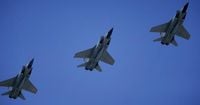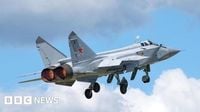On the morning of September 19, 2025, three Russian MiG-31 supersonic fighter jets pierced Estonian airspace over the Gulf of Finland, lingering for a tense twelve minutes before being intercepted by NATO aircraft. The incident, which Estonian officials have labeled as "unprecedentedly brazen," has sent shockwaves through Europe’s security establishment, deepening anxieties about the ongoing war in Ukraine and its potential spillover into NATO territory.
Estonia’s Foreign Minister, Margus Tsahkna, minced no words in his condemnation. "This is an unprecedented and brazen intrusion — clear proof of Russia’s growing aggression," Tsahkna declared on X, formerly known as Twitter. He added, “Russia’s increasingly extensive testing of boundaries and growing aggressiveness must be met with a swift increase in political and economic pressure.” According to Estonia’s foreign ministry, this marks the fourth time Russian military aircraft have violated Estonian airspace in 2025 alone, a pattern that has not gone unnoticed by NATO or the European Union.
Estonian Prime Minister Kristen Michal wasted no time in responding to the incursion, calling the violation "totally unacceptable." In a statement posted on X, Michal announced, “The Government of Estonia has decided to request NATO Article 4 consultations.” Article 4 of the NATO treaty allows any member to call urgent discussions when they believe their territorial integrity, political independence, or security is under threat. The move underscores the seriousness with which Estonia views the incident, especially given the broader context of escalating Russian military activity near NATO’s eastern flank.
NATO, for its part, acted swiftly. Spokesperson Allison Hart explained, "NATO responded immediately and intercepted the Russian aircraft," describing the episode as "yet another example of reckless Russian behaviour and NATO’s ability to respond." Italian Air Force F-35 fighter jets, stationed at Estonia’s Amari Airbase as part of the NATO Baltic Air Policing Mission, were scrambled to escort the Russian planes out of Estonian airspace. The Estonian military reported that the Russian jets entered national airspace near Vaindloo Island—a small, strategic spot in the Gulf of Finland—without flight plans, with their transponders switched off, and without any two-way radio communication with Estonian air traffic control.
This lack of identification and communication is particularly alarming to military analysts, as it not only violates international aviation norms but also raises the risk of accidental escalation. Estonian Defence Minister Hanno Pevkur told the BBC, "It is unprecedented that for 12 minutes the Russians were in our airspace. In this situation, the only right thing to do is to push them out of Estonian airspace." Pevkur also emphasized the need for NATO to "put more focus on the eastern flank," describing it as "our joint response line."
The incident comes against a backdrop of heightened tension in the region. Just over a week before the Estonian violation, Russian drones entered Polish airspace—nineteen in total, according to Polish Prime Minister Donald Tusk. Polish and NATO aircraft shot down the drones, which, while unarmed, represented the most serious cross-border incident involving a NATO member since Russia’s full-scale invasion of Ukraine in 2022. Similar incursions have rattled Romania, where the defence ministry reported detecting a Russian drone near its border with Ukraine. In both cases, NATO pledged to bolster its eastern defenses, deploying additional troops and aircraft from the UK, France, Germany, and Denmark.
European leaders have responded with a chorus of condemnation and pledges of solidarity. Kaja Kallas, the European Union’s top diplomat and former Estonian prime minister, called the latest violation “an extremely dangerous provocation.” She noted, “This marks the third such violation of EU airspace in days and further escalates tensions in the region.” Kallas continued, “We will continue to support our member states in strengthening their defences with European resources. Putin is testing the West’s resolve. We must not show weakness.”
European Commission President Ursula von der Leyen echoed these sentiments, stating on X, “Europe stands with Estonia in the face of Russia’s latest violation of our airspace. As threats escalate, so too will our pressure.” On the same day, von der Leyen proposed a 19th package of sanctions targeting Moscow over its actions in Ukraine, urging EU leaders to “swiftly approve” the measures. European Council President Antonio Costa also weighed in, announcing that the bloc would discuss a “collective response” to Russia’s actions at an informal European Council meeting in Copenhagen on October 1.
France, which maintains a military presence in Estonia, including fighter jets, described the incursion as a blatant violation of international law and noted that such an event was “unprecedented for more than 20 years.” Estonia’s ambassador to the UK, Sven Sakkov, told the BBC that “clear, practical steps” were needed to increase protection of airspace above NATO’s eastern flank, adding, “If we had to face such times as we are living in now alone, we would be extremely concerned.” Despite the gravity of the situation, Sakkov emphasized that Estonians remain “determined” to defend themselves.
Russia’s official response has been muted. The Russian military has not publicly commented on the incident. Russia’s ambassador to the United Nations, Vassily Nebenzia, told Reuters, “I do not trust what Estonia is saying about Russia.” Meanwhile, Belarus, a close Russian ally, claimed that recent drone incursions into Poland were accidental, blaming navigation system jamming for the deviation.
The timing of the airspace violation is also notable, occurring just days after Russian and Belarusian forces concluded joint military exercises, dubbed Zapad 2025. These drills have further unnerved NATO’s eastern members, who view them as a signal of Russia’s willingness to test the alliance’s resolve and readiness.
Analysts say the repeated airspace violations form part of a broader Russian strategy to probe and test NATO’s defenses while sending a message of defiance to the West. The lack of flight plans, disabled transponders, and absence of radio contact appear designed to maximize ambiguity and create confusion, increasing the risk of miscalculation.
The war in Ukraine, now in its third year, shows no signs of abating. Efforts to broker a ceasefire or peace summit have stalled, with Western intelligence officials expressing skepticism about Russian President Vladimir Putin’s willingness to negotiate. As MI6 chief Richard Moore bluntly put it, “There is absolutely no evidence that Russia’s President Vladimir Putin wants to negotiate peace in Ukraine.”
For Estonia and its NATO allies, the message from Tallinn is clear: the line has been crossed, and any further provocations will be met with unity and resolve. As the region braces for what may come next, the events of September 19 serve as a stark reminder of the fragility of peace on Europe’s eastern frontier—and the vigilance required to defend it.






